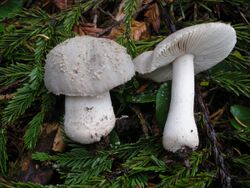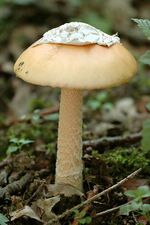Biology:Amanita farinosa
| Amanita farinosa | |
|---|---|

| |
| Scientific classification | |
| Domain: | Eukaryota |
| Kingdom: | Fungi |
| Division: | Basidiomycota |
| Class: | Agaricomycetes |
| Order: | Agaricales |
| Family: | Amanitaceae |
| Genus: | Amanita |
| Species: | A. farinosa
|
| Binomial name | |
| Amanita farinosa (Schw.)
| |
| Amanita farinosa | |
|---|---|
| Mycological characteristics | |
| gills on hymenium | |
| cap is flat or convex | |
| hymenium is free | |
| stipe is bare | |
| spore print is white | |
| ecology is mycorrhizal | |
| edibility: poisonous | |
Amanita farinosa, commonly known as the eastern American floury amanita or the American floury amanita,[1] is a North American poisonous mushroom of the genus Amanita,[2] a genus of fungi including some of the most deadly mushrooms.
Taxonomy
Two recent molecular studies show that A. farinosa is part of a subgroup within Amanita with its close relatives A. muscaria, A. gemmata and A. roseotincta.[3][4]
Description
The cap is 2.5–7 centimetres (1–3 inches) in diameter, domed in young and flat in older specimens, with a striate margin. It is whitish grey and covered with brownish grey volval or mealy material. The gills are white. They may be attached to the stem or free. They are close and crowded and not bruising. The stem, or the stipe, lacks a ring and at its base a smallish bulb or volva. It measures up to 6.5 cm high, 1–3 cm thick. The stem is white to tan in color.[5] The spores are white. They are 5.5–8 x 6–8 µm in measurement and inamyloid. The spores are smooth and round to broadly elliptical. The flesh is white in color. It does not stain on exposure.[5] In old specimens, the smell can be strong and that of mink.
Distribution and habitat
An uncommon mushroom, it is found across North America in late summer to late autumn in coniferous or deciduous woodlands.
See also
Footnotes
- ↑ "Standardized Common Names for Wild Species in Canada". 2020. https://www.wildspecies.ca.
- ↑ Phillips, Roger (2010). Mushrooms and Other Fungi of North America. Buffalo, NY: Firefly Books. p. 19. ISBN 978-1-55407-651-2.
- ↑ Moncalvo J-M, Drehmel D, & Vilgalys R. (2000). Variation in modes and rates of evolution in nuclear and mitochondrial ribosomal DNA in the mushroom genus Amanita (Agaricales, Basidiomycota): phylogenetic implications. Molecular Phylogenetic and Evolution 16:48-63.
- ↑ Drehmel D, Moncalvo J-M, & Vilgalys R. (1999). Molecular phylogeny of Amanita based on large subunit ribosomal DNA sequences: implications for taxonomy and character evolution. Mycologia 91:610-618
- ↑ 5.0 5.1 Kuo, M. (2008, March). Amanita farinosa. Retrieved from the MushroomExpert.Com Web site: http://www.mushroomexpert.com/amanita_farinosa.html
Wikidata ☰ Q1934877 entry
 |


